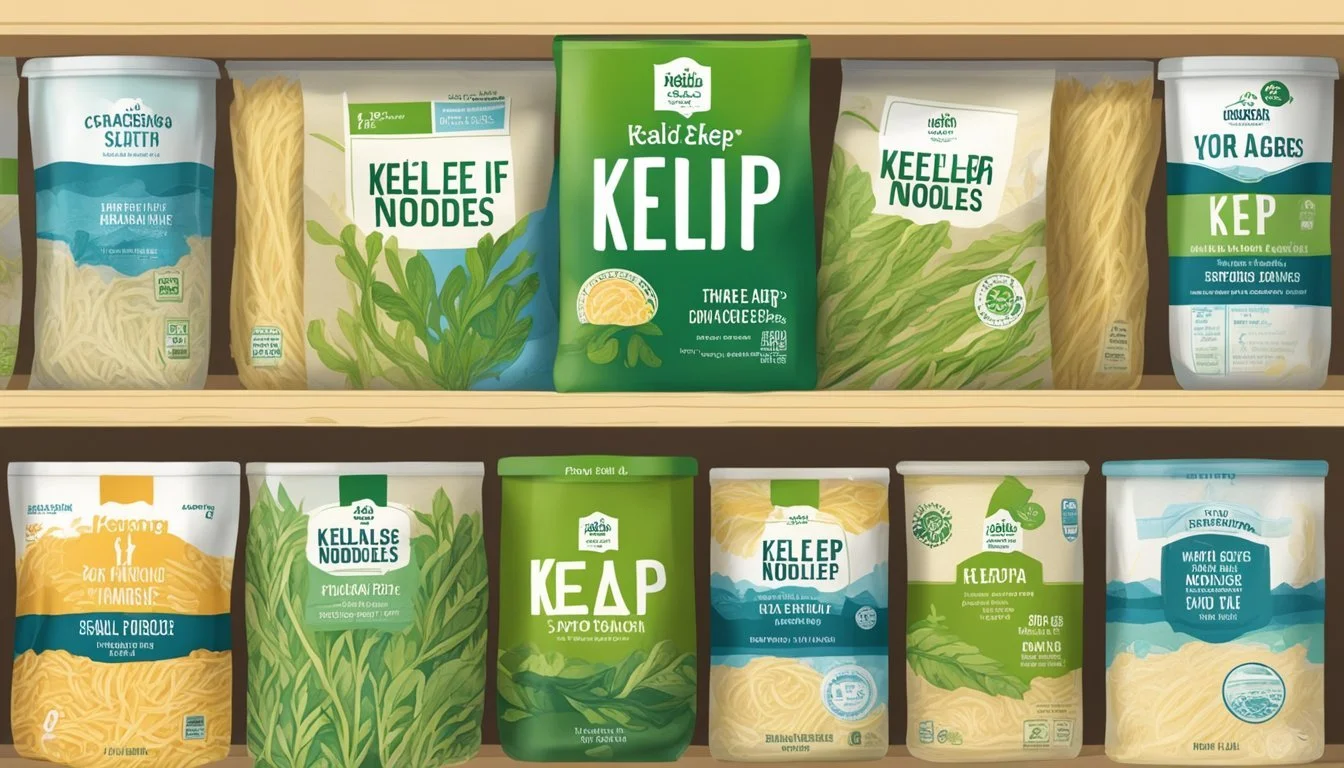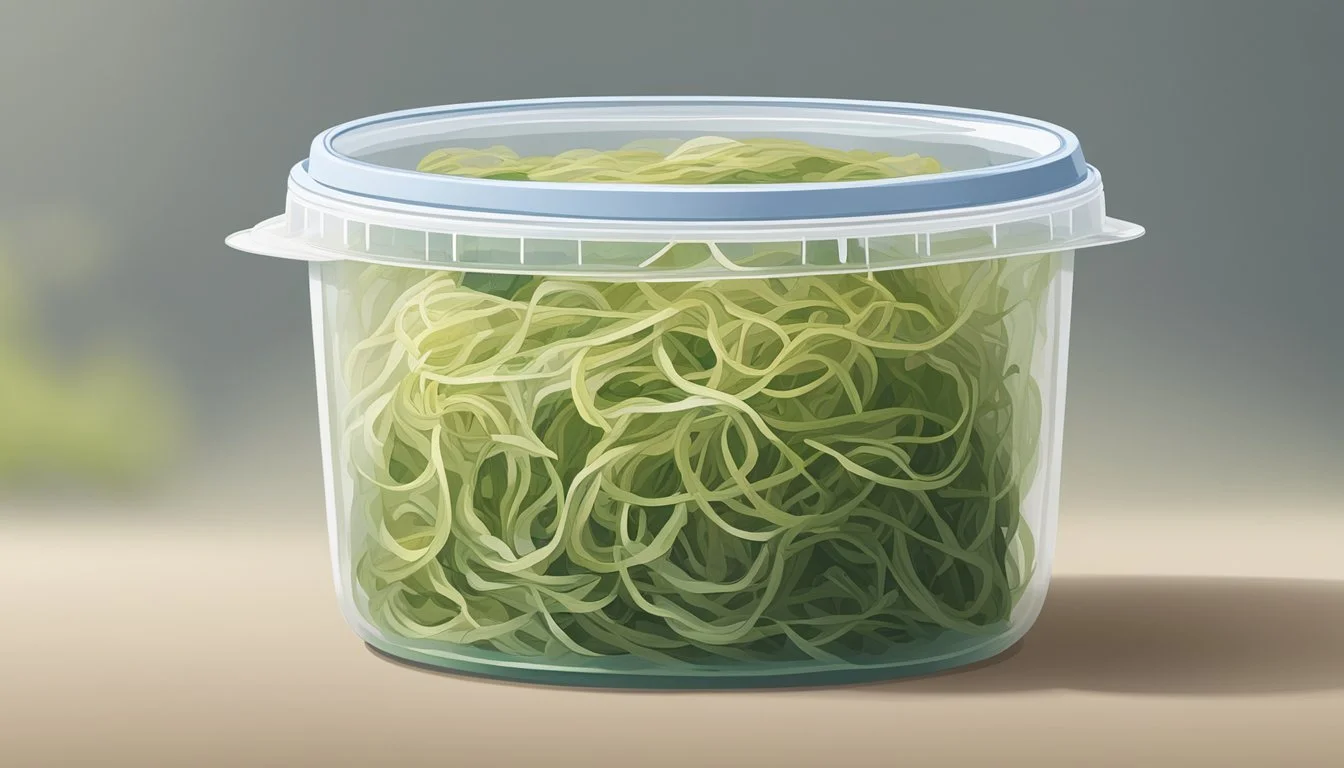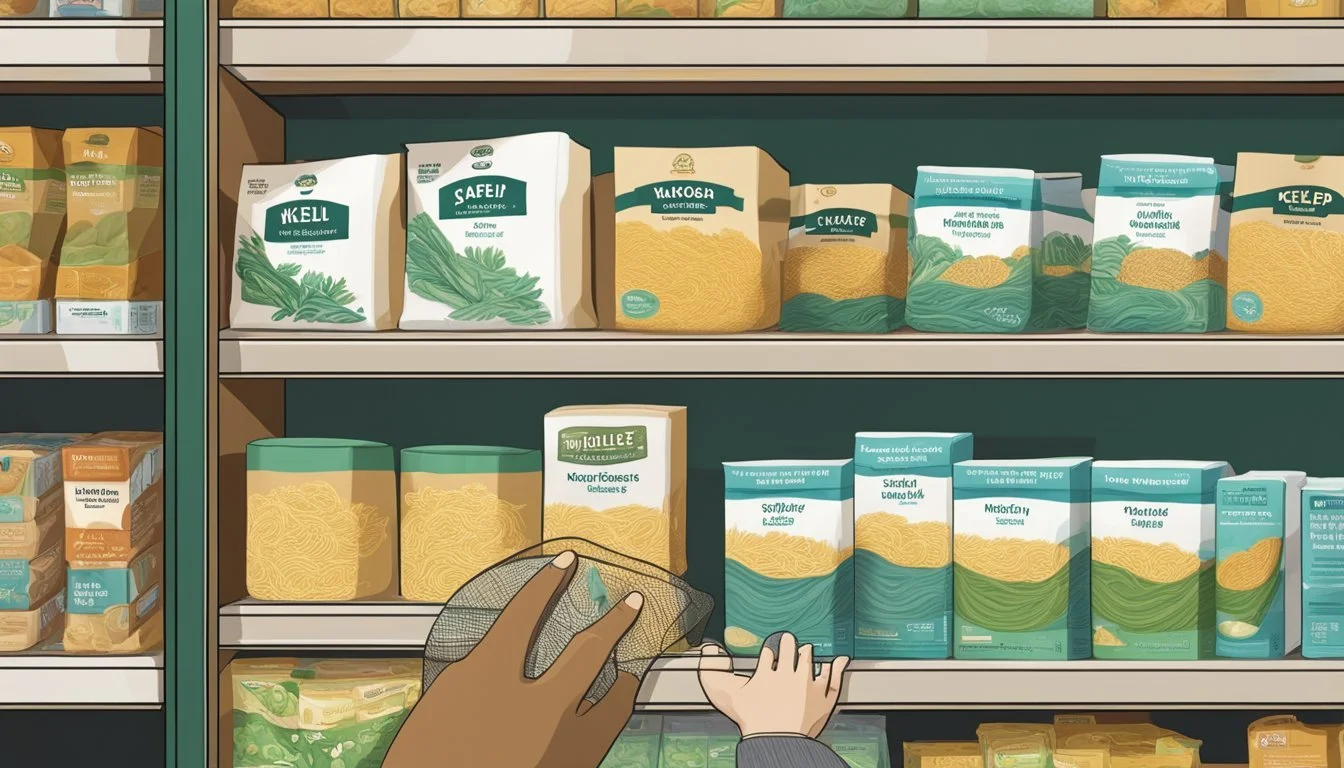How Long Do Kelp Noodles Last?
Shelf Life and Storage Tips
Kelp (how long does kelp last?) noodles, with their long shelf-life of approximately two months, have become a popular ingredient in the culinary world. These noodles, composed mainly of kelp, water, and sodium alginate, provide an alternative to traditional pasta and are praised for their health benefits. Originating from Korea, they gained traction in the 1980s and have since proven to be a versatile component in a variety of dishes due to their ability to absorb flavors while offering a low-carb, low-calorie option.
When stored properly, kelp noodles (how long do kelp noodles last?) can maintain their quality and edibility. It is important to consider the storage conditions, as they can considerably impact the longevity of the noodles. Cool, dry areas away from direct sunlight preserve the integrity of kelp noodles, preventing them from becoming compromised by heat and moisture which can accelerate spoilage.
Understanding the proper storage and handling techniques not only ensures the optimal shelf life of kelp noodles but also maximizes their culinary potential. Ensuring the noodles are fresh and high quality when utilized in dishes contributes to a better eating experience, highlighting the smooth and silky texture that is characteristic of kelp noodles when adequately prepared.
What Are Kelp Noodles?
Kelp noodles are a unique variant of noodles known for their health benefits and distinctive origin. They cater to various dietary preferences including gluten-free, low-carb, and keto diets.
Origins and Composition
Kelp noodles are a product of Korea, developed in the 1980s. Their primary components are kelp—a brown seaweed, water, and sodium alginate—a natural substance derived from seaweed used to improve the texture of the noodles. These transparent noodles, reminiscent of rice or glass noodles, are often branded as sea tangle due to their origin from oceanic kelp.
Nutritional Profile
The nutritional value of kelp noodles is notable for its low-calorie and low-carb content, which makes them a favored choice in keto and paleo diets. They are also inherently gluten-free. Rich in dietary fiber and minerals such as iodine and calcium, they contribute to thyroid health and bone strength. However, kelp noodles are generally low in protein compared to other noodle varieties. Here's a brief outline of their nutritional attributes per serving:
Calories: Typically low
Carbohydrates: Minimal
Fiber: Present
Protein: Low
Iodine: Beneficial for thyroid
Calcium: Good for bone health
Gluten-Free: Yes
Suitable for: Keto and Paleo diets
Preparation and Cooking Tips
When preparing kelp noodles, the focus should be on softening and enhancing their texture for a better culinary experience, along with creative cooking techniques and flavor pairing to best complement their unique consistency.
Softening Kelp Noodles
Kelp noodles often come in a crunchy form that benefits from softening prior to cooking. A popular method is to soak them in warm water for about 10 minutes. Alternatively, one can massage the noodles in a mixture of lemon juice and baking soda for a more thorough softening effect.
Cooking Techniques
Kelp noodles do not require the same amount of heat as traditional pasta. They are often cooked lightly or heated gently to retain their texture. One may add them towards the end of the cooking process in recipes like soup, salad, or stir-fries to avoid overcooking. They should be heated through but not boiled, preserving their al dente consistency.
Flavor Pairing
Kelp noodles have a neutral taste that pairs well with a variety of flavors from different sauces. To enhance your dish, consider bold ingredients such as pesto, ginger, or peanut sauce. They absorb flavors well, so adding spices like pepper, citrus like lemon juice or lime juice, or condiments like soy sauce and minced garlic cloves can greatly elevate the final taste of your meal.
Storing Kelp Noodles
Proper storage is essential for maintaining the quality and extending the longevity of kelp noodles. Here are specific methods to ensure they remain at their best.
Refrigeration
Kelp noodles should be stored in the refrigerator once opened to maintain their freshness. To do so, one should ensure that the noodles are kept in an airtight container or securely sealed plastic bag. This helps in preventing them from drying out and absorbing odors from other foods.
Shelf Life
Unopened kelp noodles can last up to two months on the shelf, provided they are stored in a cool, dry place. After opening, however, it is crucial to refrigerate them, and consumers should aim to use them within a week for optimum quality.
Freezing Options
While freezing is not typically recommended for kelp noodles, if one must freeze them, it should be done in a manner that prevents freezer burn. Use an airtight container or heavy-duty freezer bags to store the kelp noodles, and consume them within three months to enjoy them at their best quality.
Culinary Uses and Alternatives
Kelp noodles are a versatile and healthy alternative to traditional pasta, offering a unique texture and neutral taste that makes them suitable for a wide range of dishes. They are particularly favored in diets that require low-carb, gluten-free, or paleo options.
Versatile Recipes
Kelp noodles can be incorporated into various recipes ranging from cold salads to hot soups. They provide a refreshing crunch when served raw and become delectably chewy when cooked. Common dishes include kelp noodle salad with light vinaigrette dressing and stir fry kelp noodles, merging them with vegetables and proteins like chicken or tofu.
Substitutes for Traditional Pasta
As a substitute for traditional pasta, kelp noodles shine due to their minimal calorie count and lack of wheat and grains, making them perfect for a gluten-free diet. Their neutral flavor allows them to easily take on the taste of sauces and seasonings, rivaling classic al dente pasta in texture.
Creative Dishes
For more creative dishes, one can explore blending kelp noodles into Asian cuisines like Pad Thai and various noodle soups, offering a low-calorie and fat-free addition to these meals. When prepared correctly, they can also mimic rice noodles (how long do rice noodles last?) in a noodle bowl, expanding their use.
Enhancing Taste and Texture
To enhance their taste and texture, kelp noodles should be rinsed and soaked in warm water mixed with a small amount of vinegar and salt. This process helps to soften the noodles, reducing their naturally crunchy texture and preparing them for cooking.
Dietary Considerations
Kelp noodles are an excellent choice for those on a keto diet, as they are virtually carb-free. They are also rich in dietary fiber and can be integrated into vegan, paleo, and low-calorie meal plans. For those avoiding gluten, kelp noodles are a satisfying alternative, providing a gluten-free solution without compromising on the dish's integrity.
Health and Dietary Benefits
Kelp noodles are a nutritious food that can cater to various dietary needs due to their unique composition. They are particularly noted for being low in calories and carbohydrates, as well as naturally gluten-free.
Gluten-Free and Low-Carb Benefits
Kelp noodles are an excellent choice for individuals following a gluten-free or low-carb diet, such as keto or paleo. Since they contain no wheat or grain, they eliminate the gluten found in traditional pasta. Their low carbohydrate content also makes them suitable for a ketogenic diet, providing a pasta-like experience without disrupting ketosis.
Weight Management
As a low-calorie food, kelp noodles can be useful in weight management. With virtually no calories or fat, they create a feeling of fullness without contributing to a high calorie intake. This attribute makes them advantageous for those looking to control or reduce their caloric consumption.
Mineral and Vitamin Content
Kelp noodles are rich in minerals vital for maintaining good health. They provide necessary nutrients such as:
Calcium: important for bone health.
Iodine: essential for thyroid function, which regulates metabolism.
The dietary fiber in kelp noodles contributes to digestive health, and the presence of vitamins A, B, and C supports overall well-being. The wide array of minerals, including magnesium, zinc, and iron, further bolsters their nutritional profile, contributing to various bodily functions and maintaining mineral balance.
Comparison with Other Noodles
The shelf life and culinary uses of kelp noodles vary significantly when compared with other types of noodles. In this section, key distinctions among various noodle types, such as traditional pasta, grain-based noodles, shirataki, glass, and spiralized vegetable noodles will be discussed to provide a clearer understanding of kelp noodles' place within this diverse category.
Kelp vs. Traditional Pasta
Traditional pasta is typically made from wheat and water and sometimes includes eggs. It comes in various shapes and can be cooked to an al dente texture. Unlike kelp noodles, which have a shelf life of approximately two months and require no cooking, traditional pasta usually has a shelf life of one to two years when dried and must be boiled to become palatable.
Comparison to Rice and Grain Noodles
Rice noodles, often found in Asian cuisine, are made from rice flour (how long does rice flour last?) and water. They are known for being gluten-free, like kelp noodles, but they differ in texture and cooking requirements. Grain noodles, which can include those made from quinoa, barley, or other grains, offer a taste and texture that may vary depending on the grains used, but typically have a longer shelf life than kelp noodles.
Shirataki and Glass Noodles
Shirataki noodles (how long does shirataki noodles last?) are a low-calorie, carb-free noodle substitute made from the konjac plant. Their texture is markedly different from kelp noodles, with a gelatinous and more slippery consistency. Glass noodles, often made from mung bean starch, resemble kelp noodles in their transparent appearance and are used similarly in dishes. Both shirataki and glass noodles can serve as gluten-free options, though their nutritional profiles and storage life differ.
Spiralized Vegetable Noodles
Vegetables such as carrots, zucchini, and squash can be spiralized to create noodle-like strands. These vegetable noodles are a fresh and nutrient-rich substitute to other noodles but must be consumed within days of spiralizing to maintain their freshness and crisp texture, contrasting with the longer shelf life of kelp noodles. They offer a way to incorporate more vegetables into a meal, much like kelp noodles provide the benefits of seaweed based consumption.
Purchasing and Availability
When considering the purchase of kelp noodles, consumers should be aware of the various sources, the aspects that indicate quality, and the price points across different vendors.
Where to Buy Kelp Noodles
Kelp noodles are typically available at Asian markets where they are often sourced due to their origin in Korean cuisine. They have also become widely available online through platforms such as Amazon. For those prioritizing health, these noodles can be found in many health food stores. Brands like Sea Tangle and Gold Mine are common manufacturers of kelp noodles, and their products are often stocked in these purchasing venues.
Selecting Quality Noodles
When selecting kelp noodles, one should look for clear, translucent noodles with a mild, neutral smell. Packaging should be free from tears or leaks, and the expiration date should be checked to ensure freshness. Products from established brands like Sea Tangle and Gold Mine may offer additional reassurance on quality due to their reputation in the health food community.
Price Comparison
Asian Markets:
Usually offer competitive pricing.
Potentially lower prices due to direct sourcing from Asian countries.
Amazon:
Prices can vary widely.
Check for options with free shipping to potentially save costs.
Health Food Stores:
Prices might be higher compared to other sources.
Occasionally, store membership can provide discounts.
Consumers should consider comparing prices between these outlets to find the most cost-effective option for purchasing kelp noodles. Checking for bulk purchase options could also offer savings for those who use kelp noodles regularly.
FAQs and Common Concerns
When it comes to kelp noodles, consumers often have questions about their shelf life, nutritional content, and proper handling. This section aims to address those inquiries with certainty and clarity.
Common Questions
How long do kelp noodles last? Unopened, they generally last up to six months when stored in a cool, dry place. Once opened, they should be kept in water and consumed within a week for the best quality.
Can kelp noodles be consumed raw? Yes, kelp noodles can be eaten raw, adding a pleasant crunch to salads and cold dishes.
Nutritional Misconceptions
Are kelp noodles high in calories or carbs? No, they are low in calories and carbohydrates, making them a suitable choice for low-calorie and low-carb diets. They contain minimal protein, primarily serving as a source of iodine.
Do kelp noodles contain umami flavor? While not specifically known for their umami flavor, they can enhance the savory quality of dishes when prepared with umami-rich ingredients.
Preparation and Storage Tips
How should one prepare kelp noodles? For a softer texture, kelp noodles can be rinsed, then soaked in warm water, sometimes with added acidity like lemon juice. For use in hot dishes, they can be directly incorporated into soups or stir-fries.
What are the best storage practices for kelp noodles? Post-opening, one should store them in a container filled with water in the refrigerator, ensuring they remain hydrated for optimal freshness. It is recommended to change the water every couple of days.
Kelp Noodles in Popular Culture
As health trends continue to evolve, kelp noodles have gained prominence in popular culture, especially among dietary communities valuing low-calorie and low-carb options.
Diet Trends
Keto Diet & Paleo: Kelp noodles are celebrated within keto and paleo circles for their compatibility with these dietary plans. As a low-carb, gluten-free option, they are ideal for individuals who are cutting out traditional pastas and grains while seeking to maintain a state of ketosis or adhere to paleo guidelines.
Healthy and Low-Calorie: With a nutritional profile favoring those on calorie-restricted diets, kelp noodles serve as a versatile ingredient in various culinary creations that are both healthy and satisfying.
The inherent characteristics of kelp noodles, including their low-calorie count and minimal carbohydrate content, have helped them become a staple in modern health-conscious meals and diet-friendly recipes.











